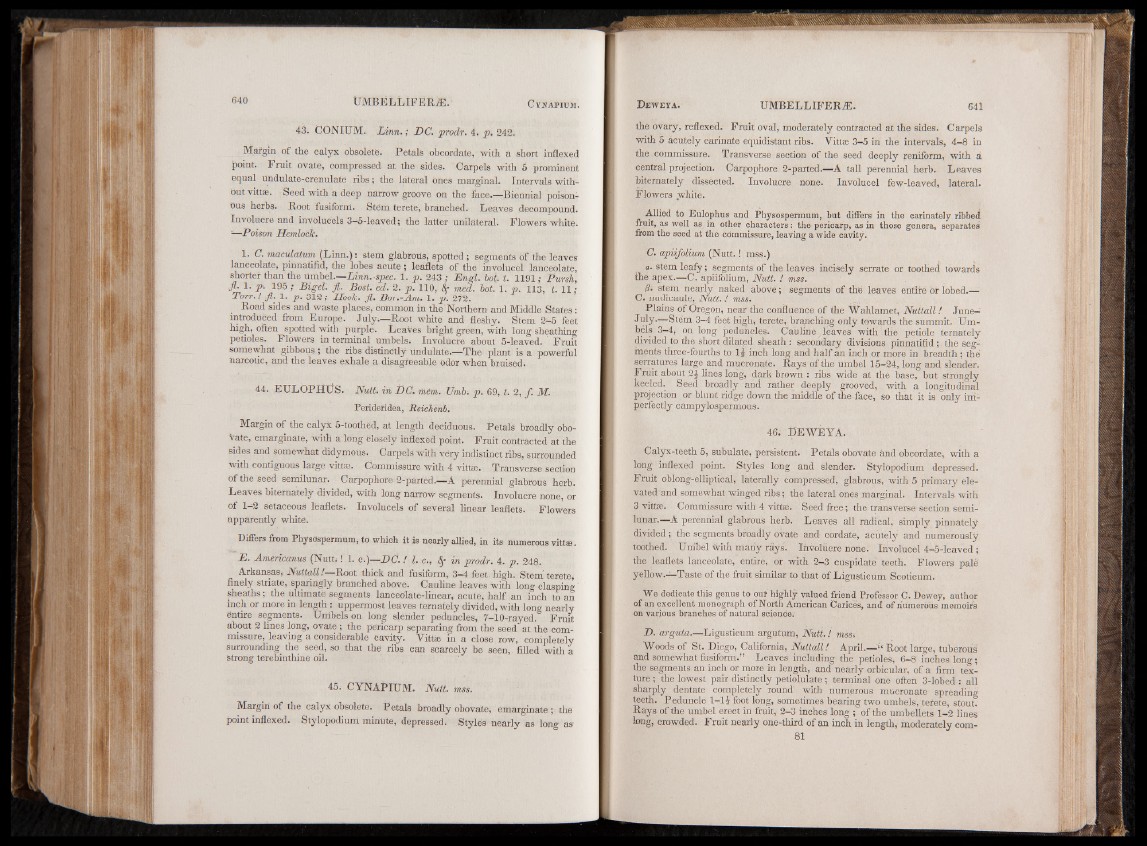
43. CONIUM. L in n .; D C . prodr. 4. p . 242.
Märgin of the calyx obsolete. Petals obcordate, with a short inflexed
J)oint. Fruit ovate, compressed at the sides. Carpels with 5 prominent
equal undulate-crenulate ribs; the lateral ones marginal. Intervals without
vitt». Seed with a deep narrow groove on the face.—Biennial poison-
bus herbs. Hoot fusiform. Stem terete, branched. Leaves decompound.
Involucre and involucels 3—6-leaved; the latter unilateral. Flowers white.
■—Poison Hemlotk.
i . C. maculatum (Linn.): stem glabrous, spotted ; segments of the leaves
lanceolate, pinnatifid, the lobes acute; leaflets of the involucel lanceolate,
shorter than the umbel.—Linn. spec. 1. p . 243 ; E n e l. 5o(; t. 1191; Pursh,
fl. 1. p . 195; BigeV. ft. Bost. ed. 2. p . 110, &• med. lot. 1. p. 113, t. IT:
T o rr.! ft. 1. p . 312/ Hoolc. fl. Bor.-Am. 1. p . 272.
Road sides and waste places, common in the Northern and Middle States:
introduced from Europe. July.—Root white and fleshy. Stem 2-5 feet
high, often spotted with purple. Leaves bright grefen, with long sheathing
petioles. Flowers in terminal umbels; Involucre about 5-leaved. ' Fruit
somewhat gibbous; the ribs distinctly Undulate.—The plant is a powerful
narcotic, and the leaves exhale a disagreeable odor when bruised.
44. EULOPHÜS. Nutt, in D C . mém. Ümb. p . 69, t. 2, ƒ. M.
Peridefidea, Reichenb.
Margin of the calyx 5-toothëd, at length deciduous. Petals broadly obo-
vate, emarginate, with a long closely inflexed point. Fruit contracted at the
sides and somewhat didymoüs. Carpels with very indistinct ribs, surrounded
With contiguous large vittae. Commissure with 4 vittae. Transverse section
Of the seed semilunar. Carpophore 2-parted.—A perennial glabrous herb.
Leaves biternately divided, "with long narrow- segments. Involucre none, or
of 1-2 setaceous leaflets. Involucels of several linear leaflets. Flowers
apparently white.
Differs from Physdspermum, to which it is nearly allied, in its numerous vitte.
E . Americanus (Nutt;! 1. c.)—DC. ! 1. c., Sf in prodr. 4. p. 248.
Arkansas, Nuttall!—Root thick and fusiform, 3-4 feet. high. Stem terete,
finely striate, sparingly branched above. Cauline leaves with long clasping
sheaths; the ultimate segments lanceolate-linear, acute, half an inch to an
Inch or more in length : uppermost leaves ternately divided, with long nearly
entire segments. Umbels on long slender peduncles, 7-10-rayed Fruit
about 2 lines long, ovate ; the pericarp separating from the seed at the commissure,
leaving a considerable Cavity. Vittas in a close row, completely
surrounding the seed, so that the' ribs can scarcely be seen, filled with a
Strong terebinthine oil. 45
45. CYNAPIUM. Nutt. mss.
Margin of the calyx obsolete. Petals broadly obovate, emarginate; the
point inflexed. Stylopodium minute, depressed. Styles nearly as long asthe
ovary, reflexed. Fruit oval, moderately contracted at the sides. Carpels
with 5 acutely carinate equidistant ribs. Vittae 3-5 in the intervals, 4-8 in
the commissure. Transverse section of the seed deeply reniform, with a
central projection. Carpophore 2-parted.—A tall perennial herb. Leaves
biternately dissected. Involucre none. Involucel few-leaved, lateral.
Flowers white.
Allied to Eulophus and Physospermum, but differs in the carinately ribbed
fruit, as well as in other characters: the pericarp, as in those genera, separates
from the seed at the commissure, leaving a wide cavity.
C. apiifolium (Nutt.! mss.)
a. stem leafy; segments of the leaves incisely serrate or toothed towards
the apex.—C. apiifolium, Nutt. ! mss.
/?; stem nearly naked above; segments of this leaves entire or lobed___
C. nudicaule, Nutt. ! mss.
Plains of Oregon, near the confluence of the Wahlamet, N u tta ll! June-'
July— Stem 3-4 feet high, terete, branching only towards the summit. Umbels
3-4, on long peduncles. Cauline leaves with the petiole ternately
divided to the short dilated sheath : secondary divisions pinnatifid ; the segments
three-fourths to 1 j inch long and half an inch or more in breadth ; the
serratures large and mucronate. Rays of the umbel 15-24, long and slender.
Fruit about 2J lines long, dark brown : ribs wide at the base, but strongly
keeled. Seed broadly and rather deeply grooved, with a longitudinal
projection or blunt ridge down the middle of tie face, so that it is only imperfectly
campylospermous.
46. i)EWEYA.
Calyx-teeth 5, subulate, persistent. Petals obovate and obcordate, with a
long inflexed point. Styles long and slender. Stylopodium depressed.
Fruit oblong-elliptical, laterally compressed, glabrous, with 5 primary ele-
vated’and somewhat winged ribs; the lateral ones marginal. Intervals with
3 vittae. Commissure with 4 vittae. Seed free; the transverse section semilunar.—
A perennial glabrous herb. Leaves all radical, simply pinnately
divided; the segments broadly ovate and cordate, acutely and numerously
toothed. Umbel -frith many rays. Ihvolucre none: Involucel 4-5-leaved ;
the leaflets lanceolate, entire, or with 2-3 cuspidate teeth. Flowers pale
yellow.—Taste of the fruit similar to that of Ligusticum Scoticum.
We dedicate this genus to out highly valued friend Professor C. Dewey, author
of an excellent monograph of North American Carices, and of numerous memoirs
on various branches of natural science;
D . arguta.—Ligusticum argutum, N u tt.! mss;
Woods of St. Diego, California, Nuttall! April.—“ Root large, tuberous
and somewhat fusiform.” Leaves including the petioles, 6-8 inches long;
the segments an inch or more in length, and nearly orbicular, of a firm texture
; the lowest pair distinctly petiolulate; terminal one often 3-lobed : all
sharply dentate completely round with numerous mucronate spreading
teeth. Peduncle 1-14 foot long, sometimes bearing two umbels, terete, stout.
Rays of the umbel erect in fruit, 2-3 inches long ; of the umbellets 1-2 lines
long, crowded. Fruit nearly one-third of an inch in length, moderately com